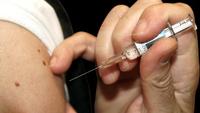-
Medical silver bullet: New drug cures most viral infections

Researchers at MIT’s Lincoln Lab have developed technology that may someday cure the common cold, influenza, and other ailments; the researchers tested their drug against fifteen viruses, and found it was effective against all of them — including rhinoviruses that cause the common cold, H1N1 influenza, a stomach virus, a polio virus, dengue fever, and several other types of hemorrhagic fever
-
-
Innovative biosensor for rapid virus field tests
Relying on a novel DNA-based bio-chemo-physical conversion method, a new bio-detection device is able to detect harmful bacteria, such as E. coli, salmonella, and staphylococcus, on site, within thirty minutes; it can be adapted to cover such deadly viruses as SARS, H5N1 flu, and swine flu viruses; it can also be designed to monitor possible biological attack from anthrax, smallpox, cholera, and more
-
-
Gold nanoparticles help to diagnose flu in minutes
Arriving at a rapid and accurate diagnosis is critical during flu outbreaks, but until now, physicians and public health officials have had to choose between a highly accurate yet time-consuming test or a rapid but error-prone test; University of Georgia researchers offer a solution
-
-
To stem the spread of disease schools reconsidering attendance policies

Due to public health concerns, a growing number of schools across the United States have stopped giving students awards for their attendance record; in an effort to maintain their attendance records, many students likely went to school while sick, greatly increasing the risk of infecting others; following the H1N1 flu outbreak in 2009, many school districts across the United States began reconsidering their attendance policies and many eventually chose to stop awarding students with perfect attendance records
-
-
Satellites could predict next cholera outbreak
With cholera making an unlikely resurgence, catching countries like Haiti and Pakistan by surprise, public health officials are exploring the potential for new technology to help stem the spread of future outbreaks; each year the disease affects three to five million people and claims more than 100,000 lives; researchers believe that satellite images of oceans could help forecast when a cholera outbreak is likely to strike
-
-
Natural antibody brings universal flu vaccine closer

Annually changing flu vaccines with their hit-and-miss effectiveness may soon give way to a single, near-universal flu vaccine, according to a new report from scientists at the Scripps Research Institute and the Dutch biopharmaceutical company Crucell; they describe an antibody which, in animal tests, can prevent or cure infections with a broad variety of influenza viruses, including seasonal and potentially pandemic strains
-
-
100 Utah employees quarantined after measles outbreak
A measles outbreak has forced a power plant in northern Utah to keep hundreds of its employees at home; last week an employee at the Intermountain Power Agency power plant in Delta, Utah tested positive for measles prompting officials to order an estimated 100 employees and contractors born after 1957 to stay home until they can show that they have been fully vaccinated
-
-
"Networking" turns up flu virus tied to 2009 pandemic
Scientists using new mathematical and computational techniques have identified six influenza A viruses that have particularly close genetic relationships to the H1N1 “swine” flu virus that swept through the United States beginning in the spring of 2009; that virus eventually killed almost 18,000 people worldwide
-
-
Method used in hunting serial killers can be used against killer diseases
Geographic profiling, a method used in the hunt for serial killers, can help combat infectious diseases; the statistical technique uses the locations of crimes to identify areas in which the serial criminal is most likely to live and work; it was originally developed to help police prioritize suspects, but can now be used to map the locations of diseases to try and identify the source of the disease
-
-
Fate of last smallpox virus samples to be determined today

The World Health Organization officially declared in 1979 that smallpox has been eradicated; in the three decades since the WHO declaration, the Centers of Disease Control and Prevention (CDC) in Atlanta, Georgia, and a Russian government laboratory near Novosibirsk have been the last two places to keep samples of the smallpox virus; during this time, there have been many calls by scientists and advocates to destroy these last samples — some of these calls accompanied by dark hints that the two countries wanted to hang on to the samples in order to use them as a basis for a future bio-weapon; the United States opposes the destruction, saying that the live samples are needed to develop vaccine with less adverse side effects as well as two other related drugs; a committee of the World Health Organization is meeting today in Geneva to make a decision
-
-
Secrets of plague unlocked with stunning new imaging techniques
Sandia Labs researchers have developed a super-resolution microscopy technique that is answering long-held questions about exactly how and why a cell’s defenses fail against some invaders, such as plague, while successfully fending off others like E.coli
-
-
California schools struggle to vaccinate millions against whooping cough
After experiencing its worst whooping cough outbreak in more than six decades, California is taking extra precautions to ensure that children are vaccinated against the preventable disease; California lawmakers mandated that all children entering the seventh grade and up must have a whooping cough booster vaccine; but parents and school districts are still scrambling to get children vaccinated before the Fall when students will be prohibited from entering a classroom without it; nearly three million students must be vaccinated making it a logistical nightmare for schools to process paperwork; in 2010, there were than 7,800 cases of whooping cough and the disease claimed the lives of ten children
-
-
Satellite information helps eradicate mosquitoes
Louisiana’s St. Tammany Parish is partnering with Colorado-based location intelligence software company aWhere, Inc. to test a new satellite-based surveillance system that can locate and analyze potential mosquito breeding sites with near pinpoint accuracy
-
-
Superbug sweeps across Los Angeles hospitals
Last week, public health officials in Los Angeles reported an outbreak of a drug-resistant superbug in several local healthcare facilities; the deadly drug-resistant strain is Klebsiella pneumonia (CRKP) and is estimated to kill 40 percent of those who are infected with it; the LA county health department has identified 356 cases of the bacteria over a six month period; CRKP has primarily been infecting senior citizens; CRKP is part of a larger wave of antibiotic germs that have plagued hospitals in recent years; the bacteria was originally found on the east coast of the United States, and was only first seen last year in the Los Angeles area
-
-
Canada launches TB website to stem spread of disease
Researchers at Canada’s McGill University recently launched a free website to help doctors around the world stem the spread of tuberculosis (TB); the website offers detailed information on TB vaccinations in over 180 countries; while TB levels are at all-time lows in Canada and the United States, TB has grown increasingly prevalent around the world particularly in Africa and India; in India, there are nearly two million new cases of TB each year and it is the leading cause of death among people between the ages of fifteen and forty-five; the International Federation of Red Cross and Red Crescent Studies recently warned that up to ten million people could die of TB by 2015; if detected early, TB can be treated with antibiotics
-
- All
- Regional
- Water
- Biometrics
- Borders/Immig
- Business
- Cybersecurity
- Detection
- Disasters
- Government
- Infrastructure
- International
- Public health
- Public Safety
- Communication interoperabillity
- Emergency services
- Emergency medical services
- Fire
- First response
- IEDs
- Law Enforcement
- Law Enforcement Technology
- Military technology
- Nonlethal weapons
- Nuclear weapons
- Personal protection equipment
- Police
- Notification /alert systems
- Situational awareness
- Weapons systems
- Sci-Tech
- Sector Reports
- Surveillance
- Transportation
Advertising & Marketing: advertise@newswirepubs.com
Editorial: editor@newswirepubs.com
General: info@newswirepubs.com
2010-2011 © News Wire Publications, LLC News Wire Publications, LLC
220 Old Country Road | Suite 200 | Mineola | New York | 11501
Permissions and Policies
Editorial: editor@newswirepubs.com
General: info@newswirepubs.com
2010-2011 © News Wire Publications, LLC News Wire Publications, LLC
220 Old Country Road | Suite 200 | Mineola | New York | 11501
Permissions and Policies
